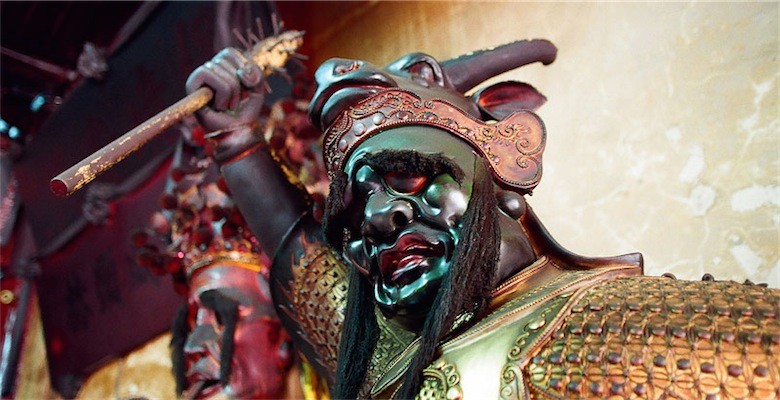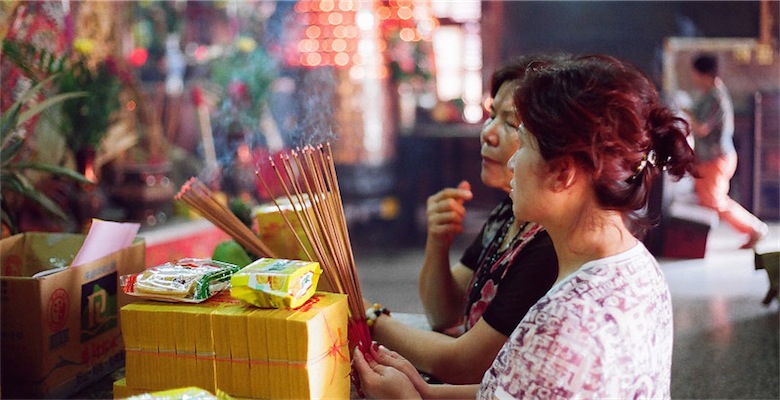
Of the many festivals and worship days in the lunar calendar, Ghost Month is one of the most visible to visitors and long-term residents in Taiwan not directly involved with local traditions and beliefs. Ghost Month begins on the eve of the first day of the seventh lunar month, when the gate between the mortal and under-worlds open up, allowing spirits to roam the world and visit the living. Ghost Month peaks on the evening of the 15th, when spirits arrive in the mortal world en masse, and Taoist and Buddhist monks complete rituals to ease the suffering of the dead. It ends on the last night of the month with spirits returning to the underworld before the gates close for another year.
Like many observances in Taiwan, Ghost Month is also about ancestral worship. Families will make offerings to their ancestors on the first day of the month. That night, Taoist priests will gather at temples to pray for the lonely ghosts (孤魂/野鬼) coming from the underworld. (You will hear the term “Good Brothers” being used to refer to these ghosts. This is the translation of the term “好兄弟 “, which is a polite reference to use, when these friends may be present.) Fearing that spirits with no family to honor them may attach to their physical bodies, the general public will not attend this ceremony.
Daily activities are influenced by beliefs surrounding the festival, and newcomers to Taiwan might be surprised by how it affects their friends’ and coworkers’ daily lives. Swimming is discouraged during this month, as water spirits may find you and use your body so they can return to the mortal world. Marriage, moving house, and making important business decisions are best avoided during Ghost Month. People also hope their children will not be born during Ghost Month, and I have known women who opted for a c-section to ensure their babies were not born during this time.
During Ghost Month, you might observe puppet shows and operas being performed at local temples or in night markets, with no visible audience, or tables of food set up with nobody eating the snacks. These offerings include physical items such as dry goods and ghost money. Entertainment is provided just for the ghosts. At other traditional performances, the first row of chairs may remain empty. These chairs are left available for ghosts that wish to enjoy the show.
My own experience of Ghost Month observances is limited, so I asked my mother-in-law to share some of her childhood memories. According to A-Ma (my mother-in-law), the dates of observance for Ghost Month used to be different in different parts of Taiwan. In her hometown of Taoyuan, residents would all take food to the temple for the hungry ghosts on the 15th and 29th days of the month. Later, they would go back and get the food to share at home, to bring peace to the family. Her family would place dry goods on the balcony and keep them there for the entire month, for the hungry ghosts wandering the streets to take back to the spirit world. Canned goods, soda, and rice were items included, as spirits could transport their “essence” easily to the spirit world without the worry of spoiling on the journey. Now, our family takes these items to the temple, and leaves the goods to be donated to orphanages and other charitable trusts once the essence of the food has been taken by the lonely ghosts.
A-Ma’s favorite memory of Ghost Month was the night every family would make little models out of sweetened flour, place them on wooden skewers, and take them to the local temple to be used in a ceremony. “We lived right next to that temple, and my two sisters and I would stay up and wait for a chance to vie for the treats when the ceremony was over. But, because we lived so close to the temple, we would wait on our beds, and then we would always fall asleep before the ceremony was over! Our friends from further away always got the treats, and we never did.”
A-Ma remembers the Zhongyuan Festival (Ghost Month Festival, 15th day) as the night of the water lantern release. Each family living in the area would be represented by a floating lantern. Lanterns would be shaped like a house and be filled with ghost money that the spirits could use in the afterlife. A family member would be chosen to carry that lantern through the streets, ending up by the riverside. Usually this family member would be the son of the family. Lanterns would be placed in the river and released to float as far as they would go. The further the lantern floated, the more good fortune the family could expect the following year.
Activities at Keelung’s Laodagong Temple and nearby Badouzi are recognized as the most vibrant of the celebrations surrounding Ghost Month and the mid-month Ghost Festival. These events are attended by many foreign tourists every year. Keelung City also holds other, related activities throughout the city during the month. Although the 15th day has passed, you can still catch some events and displays around Keelung Harbor and the Cultural Center, and visit the Laodagong Temple to see ongoing observations before August 25th.
基隆中元祭-老大公廟 Laodagong Temple
基隆市樂一路七十六巷三十七號
No.37, Lane 76, Le 1st Rd., Anle District, Keelung (inside Chenggong Park)
02-2427-3596
Open: 6 am–midnight
八斗子 Badouzi
基隆市中正區八斗街
Badou Street, Zhongzheng District, Keelung
Just out of Keelung City. You can take Keelung City Bus (No. 103) from Keelung Train Station to Badouzi stop. It’s about a 10-minute walk from the bus stop.
Chinese-language link to events running in Keelung during this month (2014/07/19 – 2014/08/25):
http://www.rs-event.com.tw/2014kmsgf/pages/k-03-01.html
Includes calligraphy event this Saturday and Sunday (16/17) at the Keelung Cultural Center and events next weekend at Peace Square outside the Keelung Cultural Center (基隆市103年度義民嘉年華活動).
Photos by Max Chang.

